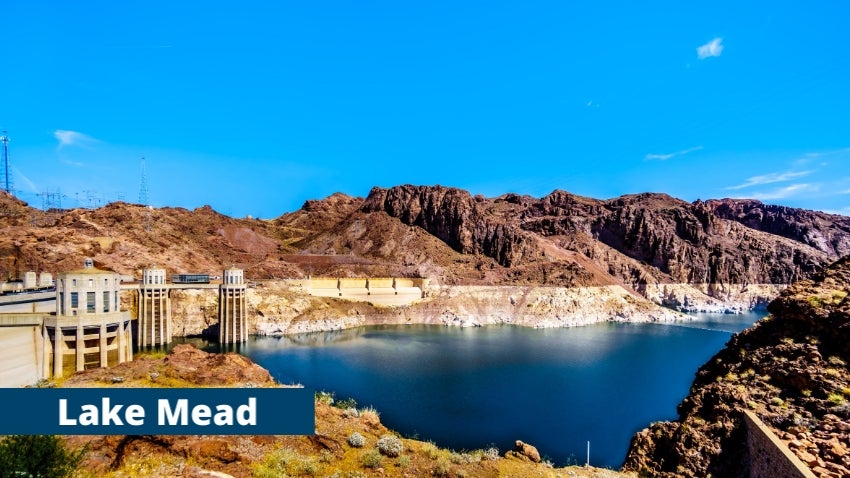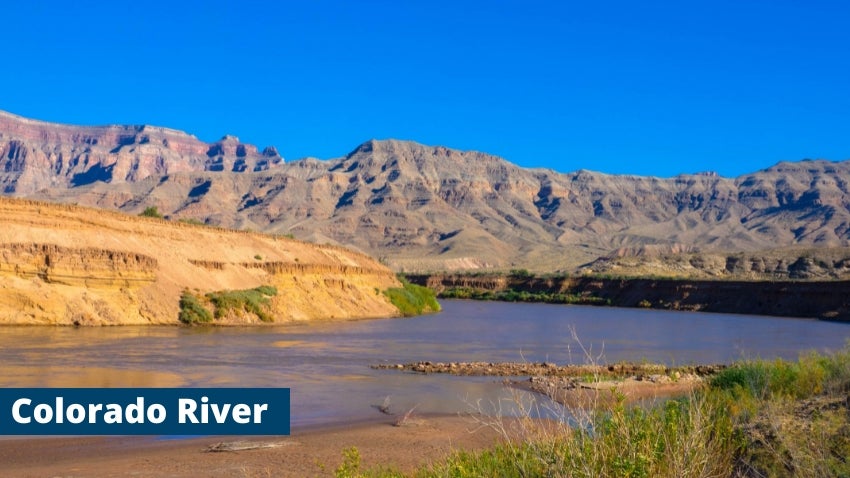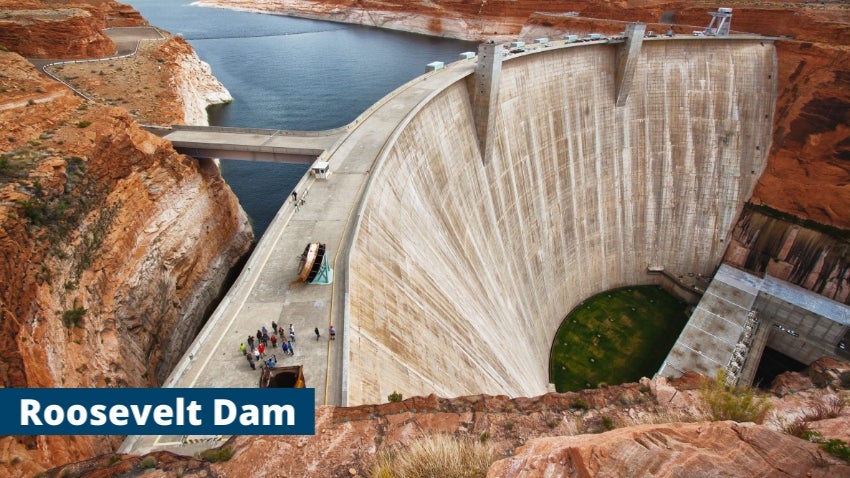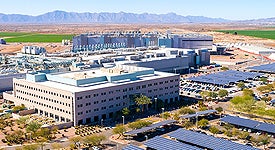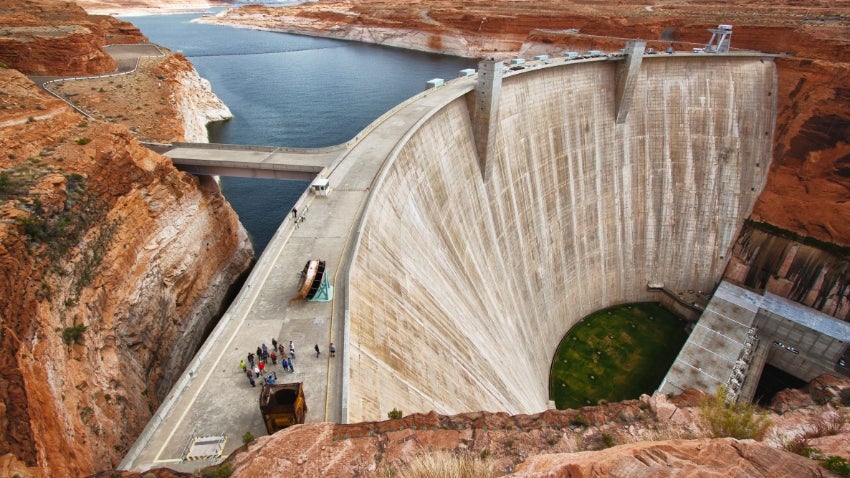
Chandler has been preparing for drought and surface water shortages for decades. Smart water management decisions and water policies help us maintain a reliable water supply. We have proactively invested in infrastructure, diverse water supplies, water reuse, storing water underground and conservation programs.
Colorado River Conditions
Rain and snow fall in the Colorado River Basin has been highly variable over the past few decades. Despite a few unusually wet years, the average natural flows of Colorado River have significantly declined. Scientists who study this river anticipate even further reductions in flow over the next few decades. Water users who rely on the river are planning for a future with less water available.
What does this mean in Chandler? In June 2022, the city activated stage one of Chandler's Drought Preparedness Plan and city staff meet regularly to review Colorado River hydrology updates, discuss the city's conservation programs and implement our enhanced communications strategy. Stage one of Chandler's Drought Management Plan remains active.
Chandler's Water Supply
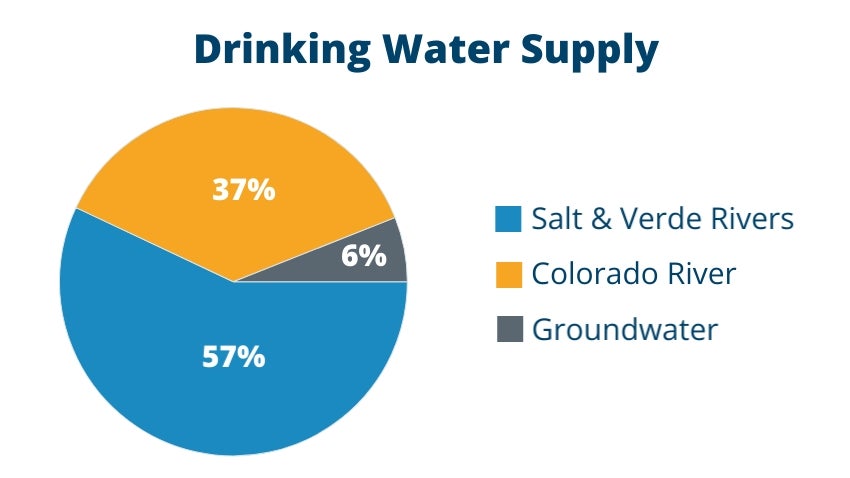
Did you know that only a portion of Chandler’s water supplies come from the Colorado River? Approximately 57% of Chandler’s drinking water supplies come from the Salt and Verde rivers. During a water shortage, the city can also rely on water stored underground over the past two decades. Chandler has enough water stored underground to last for roughly 20 to 30 years. Since the 1980s, the city has been investing in infrastructure to treat and reuse wastewater for non-potable uses such as urban irrigation, industrial uses, aquifer recharge and riparian wetlands.
Shortage Impacts to Chandler
The U.S. Bureau of Reclamation declared the first-ever shortage on the Colorado River in 2022. This shortage has continued in 2023 and 2024. Future hydrologic projections indicate that frequent Colorado River shortages are likely in the future. The Colorado River Basin States are working with tribes, cities and environmental groups to find collaborative solutions that will be needed to manage the reduced flows and agree on new shortage-sharing guidelines set to begin in 2027.
Due to Arizona's priority system, deliveries to central Arizona agricultural users have been nearly eliminated. Some cities and tribes are also experiencing supply reductions. If Colorado River supplies are reduced further, Chandler will rely on alternative supplies available. The city continues to participate in studying the possibility of regional partnerships to supply additional renewable surface water to replace reductions in Colorado River water supplies.
Drought Preparations and Water Conservation
Drought and shortage is not a short-term problem. It is a reality in the desert. That is why long-term planning is a priority in our arid climate. Effective water management and efficient water use provide the foundation for us to grow, prosper, and remain sustainable despite these challenges. Chandler’s 100-year Assured Water Supply Designation from the State, along with our Water Allocation Policy ensure reliable water supplies that support responsible growth in our community.
Chandler’s drought preparations include:
- Securing a diversified water supply to reduce its reliance on one water source.
- Implementing a progressive Water Conservation Program and Ordinances that actively promote water conservation practices, regardless of the water supply.
- Investments in reclaimed water infrastructure to ensure the City is reusing 100% of our water supplies. The City delivers reclaimed water to over 350 customers, reducing the demand for drinking water supplies.
- Constructing a reliable well program that allows the City to pump groundwater during times of surface water shortages and to meet peak summer demands.
- Developing an Underground Storage and Recovery Program that allows the City to store surface water underground so it can be recovered using City wells when it is needed during surface water shortages.
Even though we can still meet the water needs of our growing community, the City will be increasing water conservation education and marketing efforts to urge residents, businesses, neighborhoods and municipal programs to use water efficiently. Because of conservation efforts, the average Chandler household uses 20% less water today than it did 25 years ago. Chandler’s strong conservation ethic has helped us avoid the need for mandatory water restrictions, despite a 25-year drought.
Chandler residents have conserved hundreds of millions of gallons over the years. Learn more about Chandler's water conservation programs. We'll continue to encourage of culture of conservation and careful water stewardship. Chandler will continue to monitor drought conditions and Colorado River shortages for any changes and keep the community updated as new information becomes available.
Chandler’s Water Resource Manager can declare Stage One when a water shortage is predicted to impact Chandler’s surface water supplies. Chandler’s Water Resource Manager monitors hydrologic conditions and reservoir storage in both the Colorado River Basin and the Salt and Verde watershed to ensure the City is prepared before a supply reduction is made.
Stage One of Chandler’s Drought Management Plan includes ongoing monitoring and reporting of changing conditions. The City will implement an intensive drought public awareness campaign, expand water conservation messages, and conduct water loss audits for all municipal facilities to identify opportunities to save water.
No, there is no risk to Chandler’s water supplies for residential or commercial/industrial water use. The Colorado River Basin, one of Chandler’s water supplies, is currently experiencing an extended drought and residents are being asked to voluntarily reduce outdoor water use. However, Chandler is well prepared for drought and is not currently implementing mandatory restrictions.
Due to historic drought, climate and over-allocation, conditions on the Colorado River are worsening. While shortages on the Colorado River may come quicker than anticipated, Chandler has proactively invested in a diverse water supply and only a portion of Chandler’s water supplies come from the Colorado River.
Approximately 57% of Chandler’s drinking water supplies come from the Salt and Verde rivers. During a water shortage, the City can also rely on water banked over the past two decades through Arizona’s underground storage program. Chandler has stored approximately 440,000 acre feet of water underground. Additionally, Chandler has invested millions of dollars into infrastructure to treat and reuse wastewater from homes and businesses for non-potable uses.
If extreme drought conditions persist and Lake Mead levels continue to drop, Chandler’s Colorado River supplies could be impacted in the next few years. If those supplies are impacted, Chandler will rely on alternative supplies in its water portfolio.
The City is always monitoring, planning and preparing and we have a diversified water supply, including the Colorado, Salt and Verde Rivers, and groundwater.
There are many of ways to conserve water such as watering your landscape at night or very early in the morning, installing a low water use landscape, forgo the planting of a winter lawn, periodically checking for leaks both inside and outside the home.
Some of the programs that the City of Chandler offers include:
- Find and fix leaks! Chandler offers free water wise site visits.
- Smart irrigation controller rebates
- Turf removal rebates
- Xeriscape Demonstration Garden
- Online residential water calculator to identify optimal water use
- Large Landscape Water Efficiency Program (customized water budgets)
Each water provider evaluates the unique conditions that impact their own supply and demand projections and then makes a determination based on the current conditions. Chandler evaluates supply and demand frequently to ensure the City is prepared for supply reductions. Currently restrictions are not needed because of Chandler’s careful monitoring and long-range planning.
While some communities may issue mandatory cutbacks on water deliveries or fines for overwatering, Chandler has taken a voluntary approach to water conservation. Our residents have embraced a culture of conservation and reduced daily per capita water use by 20% over the past 25 years. Even with the significant growth and dry periods experienced by Chandler in recent years, the City has not had to restrict your water usage due to supply shortages. While there is no immediate impact to our ability to meet water demands, everyone is encouraged to continue their efforts to use water efficiently, because every drop counts.
No. The City implemented rules and ordinances that restrict commercial landscapes. When a new development is reviewed by the Planning and Zoning Commission, the landscaping plan is also reviewed. The exceptions are for those located in South Chandler because they use reclaimed water, or a business that was built before the ordinance went into effect.
Most large industries in Chandler are very efficient, sending most of the water that they use indoors for industrial use back to the City to be recycled and reused throughout south Chandler.
Chandler implemented a Water Allocation Policy that requires large users (businesses that use large quantities of water), that do not meet the strategic goals found in the Master Plan, to purchase and provide any additional water needed to meet our 100-year assured water supply requirements.
Agriculture is not directly served water by the City, their water use is governed and managed by the State of Arizona.
Has our water table dropped? No. The water table in Chandler has either stayed the same or raised in most areas. The Arizona State University Kyl Center for Water Policy developed this tool to show groundwater level changes across the state's sub-basins for 1-year (2017-18), 10-year (2008-18) and 20-year (1998-2018) time periods.
Chandler has enough water to support the entire build out of the community and beyond. We have carefully planned for growth and development to ensure we would have adequate water supplies for all new homes and businesses coming into Chandler. Find details at Drought Preparedness.
We are currently experiencing the driest 25-year period in at least the past 1,200 years. Two of the last four years (2020 and 2021) have been some of the driest years on record. There are tree ring studies that indicate historical “Mega-Droughts” that lasted over 30 years. Chandler will continue to plan for a hotter and drier future and strategically plan for a future with less water.
